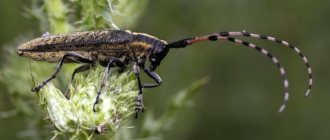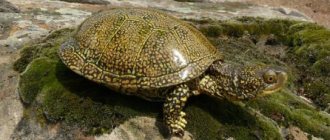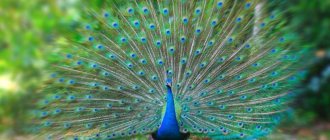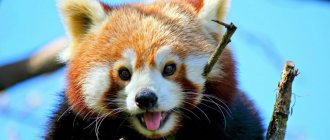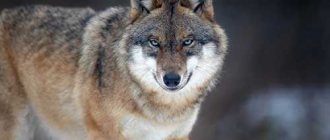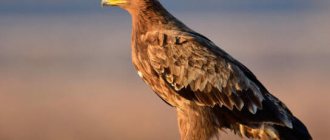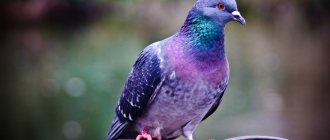- Wild animals
- >>
- Insects
A striking representative of the order Coleoptera is the relict woodcutter . This insect has impressive dimensions, long mustaches and many other memorable external characteristics. The animal received its name in connection with its behavioral and physical preferences: a tree is a home for woodcutters and serves as food for them. Other features of this insect are described in this publication.
Introduction
The relict woodcutter
,
relict barbel
,
Ussuri relict barbel
, or
Ussuri relict woodcutter
(lat.
Callipogon relictus
) is a species of beetle of the subfamily prioninae (
Prioninae
) from the family of longhorned beetles (
Cerambycidae
). Inhabits mixed and deciduous forests. Listed in the Red Book of Russia (category II - species declining in numbers). The main problems of reducing the beetle population are massive deforestation, sanitary “cleaning” of forest lands, uncontrolled collection by collectors and random individuals.
The larvae develop in drying deciduous trees - the process takes from 4 to 6 years, while the same tree can be colonized by larvae several times a year. The larvae introduce spores of the fungus Pleurotus citrinopileatus
(German)Russian, which contributes to its decomposition.
The flight of beetles occurs from the first ten days of July until September. On the territory of Russia, the relic woodcutter is the largest representative of the Coleoptera order, reaching a length of up to 110 mm. In parallel with the larvae of the relict woodcutter, the larvae of other species of longhorned beetles can develop in the same tree - heavenly longhorned beetle (in maple), Leptura thoracica
,
Rhabdoclytus acutivittis
(in maple),
Anoplodera cyanea
and a number of others.
Entomologist O.I. Ion in 1911-1913. wrote a satirical poem “An annoying insect”, dedicated to Semyonov-Tyan-Shansky and the longhorned beetle Callipogon relictus
; the relic woodcutter is also depicted on the badge of the Ussuri Nature Reserve.
Habitat
This representative of Coleoptera is quite rare. However, its habitat is quite wide. The Ussuri beetle is located in Asia, Russia and Europe. In Russia this species is found on the northwestern side. Also, the natural territory of the Ussuri woodcutter is the forests of South Korea, northeastern China and the DPRK.
Blueberry oreas
The amazingly beautiful oreas butterfly is endemic to the Far East. It is found only in this region, in the south of Primorye. They live near river banks, in mixed forests and bushes. The insect is listed in the Red Book as an endangered species.
They are colored violet-bluish, and the upper edges of the wings are outlined with a black outline. On the underside the color is much lighter, in gray shades with a bluish tint closer to the body. There are also black spots on the wings. In flight, their span reaches 30 centimeters. Oreas butterflies are very dependent on the plant Prinsepia sinensis, as their caterpillars feed only on it. Deforestation and livestock grazing reduce its number, which is why the number of insects also decreases.
What does it look like
On the territory of Eurasia, it is considered the largest representative of the entire order of Coleoptera. The size of females varies from 60 to 90 millimeters, and the size of males can reach 110 millimeters. It is also notable for being the only tropical beetle to inhabit the territory of Europe, Africa and Asia.
The external difference of the Ussuri woodcutter is its smooth jaws and elongated body structure. Because of this feature, the lumberjack's mustache looks short, although in fact it is very long. The body of these insects is colored black with a chestnut tint on the elytra. There are small white spots on the pronotum. The sexual dimorphism of these representatives lies in the length of the whiskers and the presence of small spots on the elytra. The males' whiskers are longer and have fewer small dots on their elytra.
Natural enemies of relic woodcutters
Photo: Relic woodcutter from the Red Book
The worst enemies of relic woodcutters, as well as other representatives of their vast order, are woodpeckers. These birds easily destroy larvae, eggs, and sometimes adults. Often, adult beetles become victims of other birds and animals of prey. This usually happens when insects are close to the ground. Large birds attack beetles in flight.
Parasitic microorganisms can be called the natural enemy of longhorned beetles. Various mites and bacteria do not lead to the immediate death of an adult beetle. However, they significantly undermine his health and kill him over time. Larvae are much less likely to become victims of enemies. They hide deep in the tree, in fairly secluded passages.
They are rarely attacked and destroyed:
- small parasites;
- woodpeckers;
- wasps are riders;
- other species of beetles.
Relict longhorned beetles do not often become victims of predators, parasites, and birds. Most often they die at the hands of people. It is man who can be called the main enemy of this animal. The woodcutter is a very rare, even unique insect. Almost all insect collectors and exotic lovers want to have it. The cost of such an animal on the black market can reach one thousand dollars. For this reason, there are more and more hunters for this most valuable beetle every day, despite the fact that this is strictly prohibited by law.
Story
The issue of protecting rare invertebrate animals, including insects, on a national scale in the countries that were part of the USSR, began to be raised only in the 1980s. After the October Revolution of 1917, despite the general development of entomology, the protection of insects in the countries of the then USSR, which included Moldova, was not carried out on the required scale for a long time, while the active development of agriculture and industry led to the intensive destruction of natural biotopes. Insects were not included in the first edition of the USSR Red Book, published in 1978. The second edition, published in 1984, included 202 species of insects, of which 36 species lived on the territory of the Moldavian SSR.
The publication of the “Red Book of Moldova,” then still a republic within the USSR, was established by the Council of Ministers of the MSSR in March 1976 and implemented in 1978. The Red Book of the Moldavian SSR included 29 species of animals (8 species of mammals, 17 birds, 4 reptiles) and 26 species of plants. Insects, like other invertebrates, are not included in the book. The first independent edition of the “Red Book of Moldova” was adopted in 2001 and published in 2002. There were 126 plant species and 116 endangered animal species, including 37 insect species. In 2015, the third edition of the “Red Book of Moldova” was published, already including 80 species of insects. Compared to the previous edition in 2002, it has been replenished with 48 new species of insects. At the same time, 5 species were excluded: the common praying mantis, the southern arrow, the podalirium, the extraordinary bumblebee and the carpenter bee.
Description
Adults
Male relic woodcutter
. Illustration from Jacobson’s book “Beetles of Russia, Western Europe and Adjacent Countries,” 1905-1916.
The developed body (imago) is black, with brown elytra and brown-black legs; There are two pairs of bright hair spots on the pronotum. The size and shape of the jaws and antennae varies among individuals. The antennae are dotted and quite long. Their first segment is short and thick. The third segment widens and is longer than the fourth and fifth segments combined. The fourth segment is equal to or slightly larger than the fifth, and the 11th segment is larger than the first. The lower parts of the third to tenth segments have a spike.
The mandibles are two serrated and very large in males, longer than the head; they are much shorter in females. The upper side of the jaw is covered with rough, wrinkled punctation and the lower jaw and lower lip have a thick, shaggy orange felt. The pronotum is convex, with narrow spines on the sides; The spines are larger in women than in men. The scutellum is densely covered with yellowish hairs. The elytra are very long, spotted and rounded on their upper part; they are more shiny in men than in women.
Larvae, eggs and pupae
Larvae are white, with black mandibles; the anterior half of the pronotum has a transverse red stripe, which may have four narrow grooves. The larvae have a massive body, yellowish-white and covered with sparse, small yellowish hairs. The head is strongly retracted into the prothorax, the epistome is well demarcated. Frontal seams and various longitudinal edges are sharply defined. The hypostome consists of two longitudinal sclerites that move away from each other on a regular protruding plate basis. The clypeus is small, transverse, whitish. The pronotum covers most of the head. The scutum protonum is smooth on its front, and its back is densely wrinkled. The thoracic legs are short, with long claws, covered with thick bristles.
The egg is oval in shape and is 6-7 mm (0.24-0.28 in) long. It is pink in the early stage and then darkens and turns black. The chorion egg has deep, thick, slightly faceted cells. The spaces between cells are smaller than the cells themselves.
The pupa has a strong body, the antennae are pressed to the sides. A narrow longitudinal groove runs in the middle of the pronotum. The belly is wide, strongly narrowed towards the apex. The abdominal tergites are convex and covered with short thick spines.
Original diet
What the longhorned beetle eats truly surprises outside observers. Much depends on the type and habitat of the insect. For example, the “Lumberjack” loves to eat pine needles, and the “Bark Beetle” loves to eat young branches. In general, its diet, in addition to wood, consists of the following components:
- pollen;
- leaves;
- bark.
And if a black longhorned beetle gets into the house, then its menu is supplemented:
- attic beams;
- window frames;
- ceiling rafters;
- various wooden partitions;
- floors.
It’s scary to even imagine what a house with such settlers can turn into. By and large, this is where the longhorned beetle poses a danger to humans. Otherwise, the insect evokes a smile and admiration for its attractive appearance.
Folk methods of struggle
Based on folk recipes, it is possible to prepare effective means of combating woodcutter beetles. For example:
- Take a 2.5% solution of sodium fluoride (250 g) and dilute it in 10 liters of water. Wooden structures are treated using a spray bottle, using 200 ml of product per 1 square meter.
- The product is prepared from identical parts of resin, black carbolic acid and naphthalene. The product is applied to the wood using a brush.
- It is permissible to treat wooden furniture with hot drying oil, but this method will deprive it of its attractiveness.
- Kerosene and turpentine are mixed in a ratio of 1:3. The tree is treated with Vaseline, and the prepared liquid is poured into the beetle passages. After this, the entrances are sealed with paraffin.
Reproduction
Despite the fact that the large oak longhorned beetle lives for about 3 months, the female manages to lay about a hundred eggs during this period. She looks for a place to lay eggs with the help of her mustache, which serves as her sense of smell (males use their mustache to find a partner). When choosing a tree that serves as a home and source of food for longhorned beetles, insects examine its condition. More often, beetles settle in dead or rotting wood. But they can also choose a healthy tree, which causes damage to humans.
Lifestyle of a beetle
Usually the female makes a cradle for her future offspring in cracks in the tree bark. Old oaks, hornbeams, elms or beeches are especially suitable for this. After 15 days, larvae emerge from the eggs and develop for more than two years. The photo and description of the larva of the large oak longhorned beetle is not much different from the larvae of its relatives. This is a fairly large white or yellowish creature that develops at a slow pace. A two-year larva grows up to 5-6 cm, after another year it can grow up to 9-10 cm, and in diameter - up to 2 cm.
On the small, brown-red head of the larva there are 3 eyes and powerful jaws. It moves along the passages gnawed in the wood with the help of abdominal and dorsal growths, which are also called calluses. Before the pupation period begins, the larva gnaws a tunnel in the tree, the length of which can reach 1 meter. At the end of such a move, the larva drills an oval hole, which serves as a bedroom for the future pupa. From this shelter she makes another tunnel, through which in the future an adult large oak longhorned beetle will emerge. In the meantime, the larva covers it with particles of bark and wood fibers.
No. 1 [Engineering and technical support of the agro-industrial complex. Abstract Journal, 2010]
The quarterly abstract journal is a body of current information about domestic and foreign documents on the engineering and technical system of the agro-industrial complex. Published since 2000. The annual volume is about 1200 publications. Materials for the publication are selected from current receipts in the reference and information fund of the Federal State Scientific Institution "Rosinformagrotech" and the Central Scientific Research Center of Agricultural Sciences of the Russian Agricultural Academy. The publication is intended and can serve as a reference guide for scientists and practitioners, specialists from government bodies, enterprises and organizations of the agro-industrial complex, university teachers, as well as librarians and employees of scientific and technical information bodies. The RJ includes information about the most scientifically significant book publications and articles from periodicals and ongoing publications, thematic collections on agricultural mechanization, problems of creation, production, use and maintenance of machinery and equipment for the agro-industrial complex.
Appearance and features
Photo: Insect woodcutter beetle
Most representatives of lumberjacks have average body dimensions. Only a small number belong to the group of giants - these are titanium and bigtooth. Their average length is 167 millimeters. Such animals live mainly in Young America. Beetles from Fiji are smaller in size. Their length can reach fifteen centimeters. The carpenter's barbel (up to 6 centimeters) is a giant among European species, the relict barbel (up to 11 centimeters) is a large representative of the order living in Russia.
Video: Lumberjack Beetle
A significant part of the insect's length is occupied by the whiskers. Sometimes they exceed the body length by four to five times. The body of the woodcutter beetle is slender, slightly elongated. There may be various spots and stripes on it.
The colors come in a variety of colors:
- gray-blue;
- black-brown;
- greenish;
- white;
- mother-of-pearl;
- pale yellow.
Lumberjacks can make various sounds. The sound is produced by the friction of the rib on the surface of the mesothorax. The sound is creaking, not very pleasant. Beetles use it as protection. The sound is made in the event of an enemy attack; it is of a frightening nature.
Kinds
Very rough estimates indicate about 26,000 species of these creatures, but these data often change. Almost every year new species are discovered from different places, mainly from the tropics and areas close to the equator. However, new species also appear in civilized Europe, exotic Asia and advanced America.
There are 583 species of them on the territory of Russia. Despite their diversity and abundance, these insects have been well studied by scientists. Most are average in size for beetles. But there are also giants among them. For example, the titan lumberjack, which lives in North America, reaches 19-22 cm in length.
There is another large species in South America - the Brazilian bigtooth woodcutter, the size of which can be 17-18 cm. The longhorned beetle from Fiji is the third largest of the large beetles known at the moment. Its size reaches 15 cm.
Lumberjack bigtooth
Of the European beetles, the largest at the moment is the carpenter's longhorned beetle, it is about 6 cm long. Russia also has a large representative of this species - the Ussuri relict longhorned beetle. He grew to 11 cm.
Relict barbel
There are 11 subfamilies belonging to the barbels. Let's talk about some of them. Their names: true longhorned beetles, laminae, longhorned beetles, parandrins, prionine longhorned beetles, spondylidins. Lamiinae include more than 13,000 species of beetles, many of which look elegant in appearance. For example, some have transverse stripes of black and greenish color along their wings.
Prionins include 1000 species. This is one of the oldest beetles. Found everywhere on earth except cold polar regions. The size varies greatly, from 2 mm to 178 mm, but mostly these are large beetles, sometimes even up to 22 cm.
Painted in brown, black, brown tones. It is to this subfamily that the giants among beetles belong: the titan woodcutter, the Brazilian bigtooth woodcutter and the Ussuri relic woodcutter.
Parandrins number 50 species and live in the tropics and subtropics. They are atypical for the family, as they have very short antennae, which are more reminiscent of staghorns. The color of their hard wings is usually red-brown or black.
The barbels or lepturines are a family of 100 genera and 2500 species. Small beetles, the wings are colored with yellow and black stripes.
Spondylidins include more than 100 species. These are nocturnal and crepuscular representatives. Their whiskers are also not very long, their size is smaller than their body. The color of the wings is blue-black or black-brown.
This longhorned beetle in the photo resembles a picture from Egyptian frescoes. It is very beautifully outlined, there is an interception in the middle of the body, the wings have a noble matte tint, a little like a bronze vase. The whiskers are segmented, the paws are very elegant. Just a model for a coat of arms.
Notes
- A. Semenov (1898). "Callipogon (Eoxenus) relictus sp.
n., Vertreter des neotropischen Genus der Cerambyciden in der russischen Fauna" . Horae Soc. Ent. Ross. 32: 562–580. - (English). BioLib.cz. Retrieved January 5, 2011.
- Striganova B. R., Zakharov A. A.
Five-language dictionary of animal names: Insects (Latin-Russian-English-German-French) / . - M.: RUSSO, 2000. - P. 149. - 1060 copies. — ISBN 5-88721-162-8. - Life of animals. Volume 3. Arthropods: trilobites, chelicerates, trachea-breathers. Onychophora / ed. M. S. Gilyarova, F. N. Pravdina, ch. ed. V. E. Sokolov. — 2nd ed., revised. - M.: Education, 1984. - P. 282. - 463 p. — 300,000 copies.
- Chubaryan A. O., Ishchenko V. V., Kordonsky S. G. et al.
Encyclopedia of living nature / scientific.
ed. Vilchek G. E.
and
Glazov M.
V. - Moscow: Olma-Press "Ex Libris", 2006. - T. III. - P. 87. - 160 p. — 15,000 copies. — ISBN 594847-588-3. - Nikitsky N.B.
. feeco.narod.ru. Retrieved January 5, 2011. - ↑ Nikitsky N.B.
.
"Red Book"
. sevin.ru. Retrieved January 6, 2011. - ↑ Cherepanov A.I.
Longhorned beetles of Northern Asia (Prioninae, Disteniinae, Lepturinae, Aseminae). - Novosibirsk: “Science”, 1979. - T. I. - P. 48-51. — 700 s. — 1100 copies. - . ZIN.ru. Retrieved January 5, 2011.
- Oleg Berlov.
. ZIN.ru. Retrieved January 5, 2011. - ↑ Plavilshchikov N.N.
1 // Fauna of the USSR. Coleopterous insects. Woodcutting beetles / ch. ed. Zernov S.A. - Moscow-Leningrad: Publishing House of the USSR Academy of Sciences, 1936. - T. XXI. — P. 66-68. — 611 p. — 1700 copies. - Semenov, A.
Callipogon relictus, SP. N. Horae Soc. Ent. Rossicae (English). - 1898. - No. 32. - P. 562. - ↑ Red Book of the Amur Region: Rare and endangered species of animals, plants and fungi
. author-compiler Aboimov Yu.N. and others; — Blagoveshchensk: BSPU Publishing House, 2009 (PKI “Zeya”). — 444 -ISBN 978-5-8331-0188-9 - Byun, B. K. et al. 2006. Research Report on a Natural Monument, Callipogon relictus Semenov in the Gwangneung Forest, Korea. Korea National Arboretum. pp 46
- ↑
- ↑
- Key to insects of the Russian Far East. T. III. Coleoptera, or beetles. Part 3 / under general. ed. P. A. Lera. - Vladivostok: Dalnauka, 1996. - P. 69. - 556 p.
- ↑ Identifier of forest pests / Ilyinsky A. I. - Moscow: Selkhozizdat, 1962. - P. 298. - 392 p.
Development
The larvae live in wood, making longitudinal passages, filling them tightly with fine drilling flour. The width of the passage made by the larva is 6-9 mm. After the third wintering, the last instar larva makes a cradle along the trunk at a depth of 5 cm. Pupation of the larvae in June. Massive emergence of beetles from wood in the first half or mid-July. They are most active in clear, warm weather from 12 to 16 hours. The lifespan of beetles is on average 2 weeks. After emerging from the wood, the beetles immediately begin to reproduce, laying eggs singly or in groups of 2-5 pieces next to each other. Development is often associated with trunks of relatively large diameters at a height of 0.5-10 m. The same trees are often colonized for 2-3 years in a row.
Prevention measures
To prevent longhorned beetles from causing damage to your structure, you must:
- carry out a thorough inspection of the wood for the presence of holes made by insects;
- if damage is detected, use special protective equipment;
- keep the room dry, since excessive humidity is one of the favorable living conditions for insects;
- for preventive purposes, wooden surfaces must be periodically treated with special insecticidal agents;
- for construction, use material that is not infected with insects; this is easy to verify when the wood is cleared of bark;
- If wooden structures are heavily infested, they should be replaced with new elements.
By periodically carrying out these simple measures, you can protect your home from pests.
Meeting a living fossil
Relict (giant) woodcutter (lat. Callipogon relictus
) is classified as a relic of the Tertiary period. This unique insect has been given the status of the only representative of the tropical genus Callipogon inhabiting the territory of the Old World. The rest of the giant's brothers do not leave Central and South America. The observed decline in the number of the species led to its inclusion in the Red Book of Russia.
photo: Andres Hernandez S.
The relict woodcutter has a long body and long (longer than half the body) mustache. The legs of a large beetle are equipped with claws resembling anchors. The brown color is diluted with lighter elytra and eight yellow spots emblazoned on the front back.
In the fauna of Eurasia and Russia, the relict woodcutter has no rivals of equal size. This unique insect can be safely called a unique living fossil. Sometimes he is called the Ussuri woodcutter. Entomologists introduced the insect into the family of lumberjacks (barbels), which belongs to the order Coleoptera (beetles). Having survived the change in the conditions of existence, the relic woodcutter, whose buzzing is similar to a continuous hum, continues to remain the living embodiment of an era that ended many years ago.
photo: Jim McClarin
A rare insect for the Russian Federation can be found in the Amur region, Primorsky Territory and in the southern part of the Khabarovsk Territory. Outside Russia, beetles were found on the Korean Peninsula and in the northeastern regions of China. The relict woodcutter prefers mixed and broad-leaved forests. The development of larvae most often occurs in thick-trunked trees. This list includes white elm, Manchurian ash, Amur linden and Maksimovich poplar. In the absence of such, the larvae can colonize Manchurian maple, ribbed birch and Mongolian oak. The majority of trees are usually infected with the fungus Pleurotus citrinopileatus. The latter is known to promote wood decomposition.
photo: Jim McClarin
Scientists were able to determine the duration of the development period of the larvae. It turned out that this period is measured at 3-5 years. Larvae can also develop in fallen, rotten trees. They freely make fairly long passages, the internal space of which is clogged with drill flour. Their body length reaches 14 cm, diameter - 3 cm. The pupation period occurs in June-July. Cradles are located near the surface of the trunk. The insect spends 20 to 35 days in the pupal stage. At the end of metamorphosis, the adult beetle leaves the tree.
Males are larger than females by 4-5 cm. The length of some individuals reaches 10-11 cm. The flight period starts in the third decade of July. Its end falls on the last days of August. Adults feed on the sap of linden and elm trunks. Migrating females are much more common. Beetles are active during the daytime. At night they may be attracted to sources of bright light.
photo: Nikolay Ivshin
Females attract a partner with the help of secreted secretions. The resulting pairs are located on the trees just below the area where the female will subsequently lay eggs. Love games usually take no more than half an hour. At the end of them, a devoted male does not leave his girlfriend. Its forelimbs are located on the elytra of the female. In this position, the pair rises to the site of future laying. Eggs reaching 7 mm in length can be laid in a bunch or one at a time. The maximum quantity is 28 eggs. Interestingly, the life expectancy of adults does not exceed one month. After 24 hours of laying eggs, the insects descend to the ground and die.
Deforestation (including sanitary ones) and excessive collection of larvae, pupae and beetles by random individuals and collectors contribute to the reduction in population size.
If you find an error, please select a piece of text and press Ctrl+Enter.
Taxonomy
It is a relict of the Tertiary period and the only representative of the tropical genus Callipogon
in the fauna of the Old World - its remaining representatives live in Central and South America [10].
In a special subgenus Eoxenus
the species was isolated in 1898 by the Russian entomologist Andrei Petrovich Semyonov-Tyan-Shansky on the basis of a number of characteristics that distinguish this species from other representatives of the genus [10] [13]. Thus, the relic woodcutter is distinguished by the following characteristics:
- an elongated posterior part of the body, which is why its antennae appear shorter than those of other species of the genus;
- the upper jaws are less long and practically devoid of hair;
- the edges of the prothorax bear spines rather than being jagged;
- the eyes are closer together at the crown.
According to Professor Nikolai Plavilshchikov, these signs indicate that this species has gone somewhat further in its evolutionary development than the tropical representatives of the genus common in America [10].
Lifestyle
The relict woodcutter inhabits mixed and deciduous forests. It is unknown whether it inhabits coniferous forests, but beetles have sometimes been found in pure coniferous stands. The flight of beetles occurs from the first ten days of July until September. Adults feed on tree sap that emerges from the trunks of linden, elm and some other trees. In laboratory conditions, beetles fed on sugar syrup; one female was able to drink up to 0.5 milliliters of syrup. Females are found more often, as they are more prone to flight. Beetles are active during the day and fly to light sources at night.
The larvae feed on wood and develop mainly in thick-trunked trees - akin elm, Manchurian ash, Amur linden and Maksimovich poplar; less common are Mongolian oak, acute oak, common elm, Japanese elm, ribbed birch, rare-flowered hornbeam and Manchurian maple.
Entomopathogenic fungus of the species Metarhizium anisopliae
(from the family
Clavicipitaceae
(English) Russian) is deadly for many insects, including the adult relict longhorned beetle.
Reasons for the decline in beetle numbers
The alpine longhorned beetle is a relict species that has lived on the planet for more than 5 million years. Having survived many disasters and climate changes, it is under threat of destruction as a result of habitat loss. There are several reasons for the population decline:
- cutting down old mixed forests where beech grows;
- removal of fallen trees that harbor larvae;
- replacement of deciduous forests with coniferous ones;
- uncontrolled catching of beetles for collecting.
Modern forestry methods are optimal for people, but have a negative effect on longhorned beetles. Previously, felled trunks lay along the roads for a long time. Alpine woodcutters actively used them as food plants for their offspring. Currently, the pace of work has increased, the trunks are quickly processed, cut and taken away. Mixed forests gradually became predominantly coniferous.
The use of fertilizers led to active growth of green mass, shading appeared, preventing dead wood from drying out. And the barbel larvae live in dry trunks. Fungi and bacteria develop on a damp surface, preventing the transformation of the pupa into an adult.
Features of character and lifestyle
Photo: Insect relic woodcutter
The lifestyle of the relic woodcutter largely depends on two conditions: habitat, weather. Beetles living closer to the south, in the north, begin to fly in mid-March. In other regions (Central Asia), flight begins at the very beginning of autumn. The peak activity of these animals most often occurs during the daytime. At night, insects hide in shelters. However, sometimes they are active at night, flocking to a bright source of light.
The larvae spend their entire lives in wood. The greatest number of them are found in thick-trunked trees. For example, in ash, elm, linden, poplar. Quite rarely they are found in birches, oaks, and maples. Adults live in deciduous forests and can fly from one tree to another several times a day.
Of the relict longhorned beetles, the “pilots” are not the best. During flight, these insects are very clumsy; they experience difficulty even when rising from a horizontal surface. The main reason for this clumsiness is the large size of the beetle. The larger the individual, the less it flies. Females are more adapted to flight. They are smaller in size.
Relict longhorned beetles have fairly powerful, strong jaws. They can easily bite a pencil. However, this animal does not pose a danger to humans. It does not bite, even if you catch a woodcutter and hold it in your hand.
Reproduction
Females reach a length of 58-85 mm, males - 60-110 mm. Females secrete a special secretion to attract a partner. Copulation of beetles occurs on the larval food tree below the place where the females will lay eggs after copulation; copulation lasts up to half an hour. After copulation, the male does not leave the female - he, placing his forelimbs on her elytra, together with her climbs higher up the tree to the place where the female will lay eggs. After copulation, the female lays eggs one at a time or in groups on the trunks of a food tree; for laying, the female chooses trunks with a diameter of 30 to 100 cm and places the eggs slightly obliquely relative to the surface of the bark. Over the course of her entire life, a female can lay up to 28 eggs. An adult beetle lives from half a month to a month. Having laid eggs, both barbels descend to the ground within a day and die.
The hatched larvae bore under the bark. Under the bark they make passages up to 40 cm in length (the width of the passage is up to 2 cm), then they go deeper into the wood, leaving on the surface an entrance hole extended longitudinally to the trunk. In the wood at a depth of 5 to 30 cm, the larvae make longitudinal, transverse or winding (sometimes crossing or merging) passages, tightly clogged with drill flour. In wood, the stroke width is from 2.8 to 11 cm, in diameter from 2 to 2.5 cm.
Larvae of different ages can be found in the food tree, since the tree can be colonized several times a year; completely dry trees are required for the larvae to develop. Often due to the introduced fungus Pleurotus citrinopileatus
, the branch rots greatly and breaks, falling to the ground with all the larvae, but the latter do not die, but continue to develop; these larvae will produce adults smaller in size than those whose larvae developed in a standing tree.
The larvae overwinter (English)Russian. from 4 to 6 times; after the last winter in wood at a depth of 20 cm, they make spacious cradles across the trunk; these larvae can reach 100-150 mm in length. A layer of wood of 2 cm or more remains between the surface and the cradles. After the construction of the cradles, the larvae in them turn their heads to the surface of the trunk and after some time pupate; Pupation occurs between June and July. According to various sources, pupae develop in 20 or 28–35 days and reach a length of 70–110 mm.
Females emerge from cradles several days earlier than males; within a few days after emergence, they feed additionally.
Social structure and reproduction
Photo: Relic woodcutter
The process of procreation of the relic woodcutter can be represented in stages:
- searching for a suitable pair. The mating season begins in spring. To attract males, females secrete a special secretion;
- pairing. For love games, the beetles descend below the place where the female planned to lay eggs. The entire mating process lasts about thirty minutes. After mating, the male does not immediately fly away from the female. He accompanies her to the place where eggs will be laid in the future;
- laying eggs. At one time, a female woodcutter manages to lay about twenty-eight eggs. They are deposited on the trunk of the food tree. It is in the selected tree that the larva will live, develop and feed.
About a day after laying eggs, the female and male descend to the ground. There they die.
Larval stage. When the larvae hatch, they penetrate deep into the tree bark. There they make moves. In one tree you can find many larvae of different ages. The same tree can be inhabited several times. The larvae overwinter in the food tree about six times. Pupation, transformation into an adult. The transformation into a pupa usually occurs in the summer - during June-July. The pupae develop for about a month, at the end of the period they reach from seventy to one hundred and ten millimeters.
Population and species status
Photo: Dung beetle rolling a ball
The population of dung beetles numbers about 6,000 species. The ecosystem contains many coexisting species of dung beetles, so competition for dung can be high, and dung beetles exhibit a variety of behaviors to be able to secure dung for feeding and breeding. The dung beetle population is not in danger of extinction anytime soon.
Dung beetles are powerful recyclers. By burying animal dung, beetles loosen and nourish the soil and help control fly populations. The average domestic cow sheds 10 to 12 pieces of manure per day, and each piece can produce up to 3,000 flies over the course of two weeks. In some areas of Texas, dung beetles bury about 80% of cattle manure. If they didn't, the manure would harden, the plants would die, and the pasture would become a barren, stinking landscape filled with flies.
In Australia, native dung beetles could not keep up with the tons of manure deposited by livestock on pastures, leading to a huge increase in the fly population. African dung beetles, which thrive in open fields, were brought to Australia to help with growing dung heaps, and today rangelands are thriving and fly populations are under control.
The dung beetle does exactly what its name says: it uses its own dung or the dung of other animals in some unique ways. These interesting beetles fly around in search of the dung deposits of herbivores such as cows and elephants. The ancient Egyptians held the dung beetle, also known as the scarab (from their taxonomic family name Scarabaeidae), in high regard. They believed that the dung beetle made the Earth rotate.
Tags:
- Coleopterida
- Panarthropoda
- Scarabaeiformia Crowson
- Bilaterally symmetrical
- Coleoptera
- Animals of Australia
- Animals of Europe
- Animals of the forest
- Meadow animals
- Animals starting with the letter Z
- Animals starting with the letter N
- Animals of the fields
- Animals of the Subtropical Zone of the Northern Hemisphere
- Animals of the Subtropical Zone of the Southern Hemisphere
- Animals of the Subequatorial Belt of the Southern Hemisphere
- Animals of Texas
- Animals of the tropics
- Animals of the Tropical Zone of the Southern Hemisphere
- Animals of the Temperate Zone of the Northern Hemisphere
- Animals of the Temperate Zone of the Southern Hemisphere
- Interesting animals
- Winged insects
- Shedding
- Dung beetles
- Insects with complete metamorphosis
- Unusual animals
- New-winged insects
- Protostomes
- Lamellaridae
- Herbivorous beetles
- Scarabaeoides
- Tracheal breathing
- Amazing animals
- Arthropods
- Hexapods
- Eukaryotes
- Eumetazoans
Security
Despite its wide distribution area, the alpine barbel is on the verge of extinction. The Red Book of many countries, including Russia, contains an entry that this beetle, as a rare relict species, is under state protection. It was on the verge of extinction in the Czech Republic, Slovakia, Slovenia, Hungary, Germany and Poland. Its numbers have sharply declined in recent decades in Belarus, Azerbaijan, Armenia, and Ukraine. It is already almost impossible to find this beautiful bright beetle in Moravia and the Balkans.
The reason for this is very simple: massive and uncontrolled deforestation, especially deciduous and mixed forests, as well as irresponsible trapping of beetles, since the alpine longhorned beetle is a coveted exhibit among collectors who pay several hundred euros for it.
The international community is also taking measures to preserve the bright and amazing beetle in nature - it is included in the European Red List, as well as in the Red List of the International Union for Conservation of Nature, and is protected in many nature reserves.
Features of character and lifestyle
Photo: Insect relic woodcutter
The lifestyle of the relic woodcutter largely depends on two conditions: habitat, weather. Beetles living closer to the south, in the north, begin to fly in mid-March. In other regions (Central Asia), flight begins at the very beginning of autumn. The peak activity of these animals most often occurs during the daytime. At night, insects hide in shelters. However, sometimes they are active at night, flocking to a bright source of light.
The larvae spend their entire lives in wood. The greatest number of them are found in thick-trunked trees. For example, in ash, elm, linden, poplar. Quite rarely they are found in birches, oaks, and maples. Adults live in deciduous forests and can fly from one tree to another several times a day.
Of the relict longhorned beetles, the “pilots” are not the best. During flight, these insects are very clumsy; they experience difficulty even when rising from a horizontal surface. The main reason for this clumsiness is the large size of the beetle. The larger the individual, the less it flies. Females are more adapted to flight. They are smaller in size.
Relict longhorned beetles have fairly powerful, strong jaws. They can easily bite a pencil. However, this animal does not pose a danger to humans. It does not bite, even if you catch a woodcutter and hold it in your hand.
Varieties: names, photos and descriptions
There are about 26,000 species of longhorned beetles. There are about 583 species in Russia
Attention. The largest representatives of this family live in South America:
- The titanium beetle can be up to 17 cm long (excluding the length of the mustache).
- The stag beetle (large-toothed staghorn beetle) reaches a length of 18 cm.
- Barbel from Fiji - length up to 15 cm.
The largest barbel in Russia is the relict Ussuri (up to 11 cm in length). There are 11 subfamilies belonging to representatives of this class. Let's look at a few of them.
The following are the names, descriptions and photos of beetles with long antennae.
There are more than 13,000 species of laminins; these insects have very elegant colors.
A family of 100 genera and 2500 species. These are small insects whose wings have yellow and black stripes.
Parandrines
Includes about 50 species. Habitat: tropics and subtropics. They are unlike other long-horned beetles - they do not have long mustaches, they are more reminiscent of staghorns.
Prionin barbels
There are 1000 species. This is one of the most ancient beetles. Size from 2 mm to 22 cm. Colors are brown, black, brown. The subfamily includes giants among beetles:
- woodcutter titan;
- Brazilian bigtooth lumberjack;
- Ussuri relic woodcutter.
Spondylidins
There are more than 100 species. These are insects whose activity occurs at night or twilight. Their mustaches are of medium length. The color of the wings is bluish-black or black-brown.
Why are longhorned beetles dangerous?
The longhorned beetle feeds exclusively on bark and plants, it does not bite and poses no danger to human health, but the bark beetle poses a great threat to human property. Hatching from the pupa, the beetle gnaws its way out, so the main sign of the presence of a pest in the home is wood dust and white powder on wooden structures. The wood inhabited by bark beetles is soft, you can see passages on it; if you insert a knife blade into it, it will easily go in without effort.
In complete silence you can hear rustling and clicking sounds - this is the sound of a gnawing beetle. However, the greatest harm to a residential building is caused by the longhorned beetle larva, because it lives in the thickness of the tree, destroying it for many years until it turns into an adult. Even after the tree has completely died, the larvae can remain in it for up to 50 years, feeding from the inside.
Protection of relic woodcutters
Photo: Relic woodcutter Red Book of Russia
The Ussuri longhorned beetle is the smallest species of the longhorned beetle family. Small populations of this insect inhabit broad-leaved, mixed types of forests. Today, this type of insect is protected by law. It is listed in the Red Book of Russia due to a significant decline in populations in their natural habitat. Longhorned beetles are classified in the second category and are recognized as a declining species.
Scientists have named the three most significant reasons for the reduction in the number of relict woodcutters: deforestation, uncontrolled catching of adult individuals by exotic lovers, and deliberate cleaning of forests from pests (woodcutters harm the wood).
The destructive effects of these factors led to the rapid extermination of beetles. Today, relic woodcutters are protected by law. On the territory of their natural range, trapping and hunting of adult beetles is strictly prohibited. If this rule is violated, a person may receive a fine. Longhorned beetles have also been introduced into many Russian nature reserves, where scientists can monitor their populations and more carefully protect them from illegal catching. In addition, the government began to control deforestation in order to preserve the habitats of these insects.
The relic woodcutter is one of the most unique species of longhorned beetles; it is a very large and beautiful representative of beetles. Large dimensions, extraordinary appearance, long mustache - all this makes this insect unique in its kind. This is not to mention the fact that it itself is recognized as a living “fossil”. Unfortunately, in recent years the number of these beetles has decreased significantly. All this requires people to quickly take effective measures to protect woodcutters in their natural habitat.
Sky barbel
Sky longhorned beetle, also known as emerald rosalia (Rosalia coelestis). A very rare and beautiful species from the large family of longhorned beetles (also known as woodcutters). The maximum size of the beetle is 3.2 cm; there are smaller specimens – 1.5 cm.
It is distinguished by its characteristic color, consisting of bright blue or turquoise and black stripes not only on the body, but also on the legs and antennae. Its close relative the alpine barbel has a similar color, but the latter has a grayer color, and the individuals themselves are slightly larger.
Sky barbel
Unlike its relative, the alpine barbel, which is quite common in Europe, it is possible to meet the sky barbel only in the forests in the northeast of China, Korea and in the Primorsky Territory, in its southern part.
This species has always been quite rare, and due to constant deforestation, the number has decreased to the point that the sky barbel was listed in the Red Book.
The species was recorded several times in single specimens in the Ussuri Nature Reserve, where it was taken under protection.
The sky longhorned beetle, like other species of this family, has a rather long development path, because before it is born in the form of a beetle, it lives in the bark of a maple tree with green bark as a larva for up to four years. While the lifespan of the beetle itself is very short, it lives for two to three weeks, during which it eats nothing, and all its energy is directed toward reproduction.
The sky barbel undergoes a complete transformation, which means that it has four stages of development - egg, larva, pupa and the beetle itself. For their offspring, sky longhorned beetles select the thickest trunks, preferring trees of a certain type - maple with green bark. Very rarely their choice stops at other trees, often also maples.
Read
The most terrible mythical creatures (half-humans - half-animals)
Sky Barbel Larva
However, occasionally they are able to move to other species, but always exclusively deciduous. An important criterion for selection is the fact that the selected trunks must be dried, but not fallen. The same trees serve to lay eggs for several generations of beetles. It is the cutting down of dead trees with large trunks that leads to the fact that the number of the sky longhorned beetle is greatly reduced every year.
One female sky longhorned beetle can lay up to 60-80 eggs. In order for the eggs to get into the tree, the beetles look for various cracks, crevices or passages of bark beetles in it. The placement of eggs in the trunk can be different, either in a small group of up to 5 eggs, or individually. The larvae that appear inside the trunk in the second half of August always move only along it. In the last year, the larva, ready for rebirth, gnaws out its cradle, where over the course of three weeks it first turns into a pupa, and then into an adult beetle ready for reproduction.
The larva of the sky longhorned beetle is slightly larger in size than the beetle - 3.5 cm, while the pupa has a maximum size of 2.8 cm.
Emerald longhorned beetle
The bulk of the beetles appear in July, most often in the middle of the month, but they also appear at the beginning. Longhorned beetles love warm sunny weather, especially midday; on cloudy days it is impossible to see them on the surface of trees. The fact was noted that the species reacts to rustling (if you scrape a fingernail along the bark of a tree), beginning to actively crawl towards the source of the sounds.
Woodcutter beetle
Rosalia emerald is a completely peaceful neighbor for related species. Thus, in one tree, the larvae of the celestial longhorned beetle and the relict woodcutter, a much larger representative of the same family, are able to develop quite peacefully.
In 2012, Russia issued a commemorative coin with a face value of 2 rubles, the reverse of which depicts a heavenly barbel.
Tags: woodcutter beetle, sky barbel
